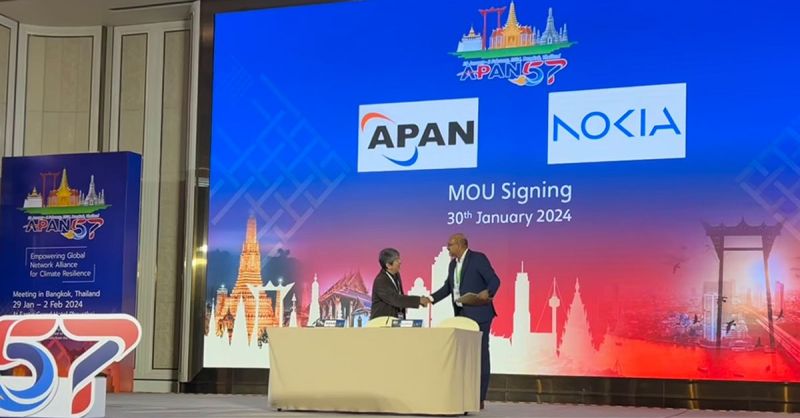Nokia Podcast at TNC24 Featuring SingAREN President’s Views On The Memorandum of Understanding (MoU) Between Nokia And APAN Alliance
27 Sep 2024 – During the APAN57 conference held in Bangkok Thailand in Jan 2024, APAN and Nokia have formalized their strategic alliance through a Memorandum of Understanding (MoU)1. Prof Shinji Shimojo, Chair of APAN Board of Directors, and Nokia’s Mathew Simon, Head of Industry Solutions Sales – APAC NI, signed the MoU to set the stage for collaboration in advancements in network communications across the Asia-Pacific region, in particular, for the NREN applications.

Figure 1 Nokia-APAN MOU Signing Ceremony at the APAN57 Conference (Photo credit to APAN57 organiser)
In a recent release of Nokia’s RE:Connect Podcast2 conducted at TNC24, Rennes France in June 2024, A/Prof Francis Lee, President of SingAREN, was interviewed by the Head of Executive Communications for the Network Infrastructure Group at Nokia, Ms Kate Winn to share his insights on this MoU together with Mr Philippe Gerard, Head of Nokia’s Public Sector and Emerging Segments in APAC. A brief excerpt from the conversation with A/Prof Lee is provided:
Q: How do you see your network evolving to support the demands of scientists and researchers who you serve?
A: SingAREN is an exchange point where we have grown from 1 GE to 100 GE, and now towards 400 GE in bandwidth. Research has grown tremendously and is more data intensive now. Different research groups have diverse requirements in terms of bandwidth and services. In addition to basic transmission, SingAREN offers extra services like data-mirroring and eduroam to facilitate researchers to move around.
Q: What is your vision for APAN in the next 5 to 10 years?
A : APAN serves a community consisting of a diverse mix from developed countries like Australia with AARNet3, and less developed countries like Nepal, Bhutan. One of our goals is to help those from less developed countries to advance in their network technology. APAN has proven to be a tremendous platform, serving as a critical hub for the community to collaborate and exchange knowledge on both technology and applications. For example, we have disaster management to share knowledge on how to handle and mitigate some of the disasters, and remote telemedicine to train physicians in less developed nations.
Q: APAN network not only connects with its own members but also peers with other organizations such as GEANT and Internet2. How do you coordinate with these organizations to ensure capacity and performance for the global scientific community?
A: We have a group of network engineers that meet regularly to set things up. At the CEO level, we collectively coordinate purchases of international links so that we buy diverse links. Recently, we had several cases of broken links due to cable cuts; because we have MoUs in place, i.e. Asia Pacific-Europe Ring4 (AER) MOU, we could divert the traffic to other operating links that are owned by partnered NRENs. The beauty of NRENs is that we can cooperate in a friendly manner to help each other in such situations.
In summary, A/Prof Lee stated that, in contrast to serving a fixed network requirements of an enterprise, NRENs need to be agile in order to meet and handle the wide range of requests from researchers in a secure manner. He also saw a live demonstration of Nokia’s 800GE5 performance at the Nokia Singapore office recently and was impressed by the results. Hence, he believe that Nokia, as a leading player in networking technology and a new addition to the APAN community, Nokia is in the right position to bring upon greater interaction between the industries and the NRENs to explore advanced communications through knowledge exchange and joint events, fostering innovation in the Asia-Pacific region.
References:
- APAN57-Nokia MoU signing ceremony
- Listen to Nokia-APAN Podcast at TNC24
- Australia’s Academic and Research Network – AARNet
- Asia-Pacific Europe Ring (AER)
- SingAREN article on Nokia Singapore 800GE demonstration visit


